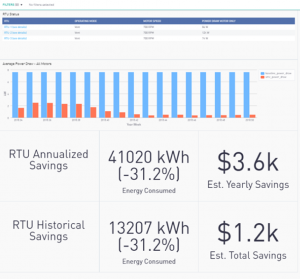Peter Drucker wrote, “What gets measured gets managed.” Thanks to advances and cost declines in sensor and communication technology, facilities are collecting more measurements than ever before. But to what end goal? Minimizing energy consumption and achieving performance targets has to respect the comfort of the tenants – turning out the lights while your $100k+/yr engineers work overtime isn’t a positive ROI.
Sadly, many facilities managers are intimately familiar with the need for regular commissioning as an energy saving overhaul. A well-thought-out effort to get all the set points and schedules just right is often overridden and deteriorates once attention has moved on to another project. Energy managers do their best but thanks to renewable energy and dynamic pricing the problem is more complex than ever. LEDs have modernized the lighting energy spend but electric motors driving HVACR equipment are based on 100+ year old AC induction motor technology – can you blame them for forgetting setpoints? Any hope of achieving real energy impact has to include electric motors as they have more than double the power footprint vs. lighting. Until recently, there has not been a reasonable and retrofittable solution to these sub-optimized energy users.
Thanks to ubiquitous connectivity and transparency, a mega-trend in the world has been a positive increase in accountability for those that sell value. Traditional “recurring revenue” business models used to be: 1) get the customer with a big commitment to lock in, and 2) make high margins on ongoing replacement parts. Think about the last time you had to take a highly engineered vehicle to the dealer for off-warranty repairs – not a pleasing feeling for the customer paying the ‘recurring’ revenue to the vendor!
In contrast, look at Amazon, Netflix or Salesforce. No major upfront CapEx and the customer can easily switch if a superior offering presents itself. They earn customer trust because they fight to be the best and continuously improve every day. Tesla’s electric vehicles automatically improve every month as they get a new software update to improve the self-driving capabilities.
What if there was an energy conservation measure that was like this – transparently high performing, no capex commitment, and continuously improving?
The inundation from suppliers that claim to have the next best energy conservation idea is daunting. What is really needed is a straightforward and unquestionable method for evaluating the performance of energy conservation measures. Too many times measurement and verification methods are confused by external variables, building load changes, occupancy, and other factors. Without an almost “real-time” method of identifying if efficiency efforts and investments are proving successful, it is difficult to obtain capital and ultimately make the best decisions to reduce energy usage and ultimately the carbon footprint of facilities.
SMC manufactures Optimal Efficiency Motor systems that have proven to reduce the energy consumption caused by motors in HVAC, ventilation, and pumping applications by 40% and more depending on the application. Performance reporting is built into our systems. During pilots, and on an ongoing basis, users get near real-time validation of the technology which is simple to present against performance targets to company financial officers as well as facility managers and engineering teams.
This ability to report motor performance over time is an integral part of our solution and provides a multitude of benefits related to operational efficiency and possible diagnosis of equipment issues.
Our initial installs almost always start with the installation of measurement and verification equipment focused specifically on the electric motor we are replacing. This creates a clean

baseline that we measure performance against after we implement our high-efficiency SMC Smart Motor Systems. This information is provided to the customer via a dashboard that can be viewed “real time” from any mobile device or PC connected to the Internet. The dashboard shows historical energy savings and provides an estimate of total dollars saved based on utility rates in the location of the site. In addition, we use a running average to project annualized savings. This tool, along with knowing the installed cost of our system, makes the ROI/payback period (and decision for future purchases) very clear to the customer.
Continuously connected energy conservation measures that ensure performance targets are met is possible with lower-cost metering equipment and low-cost, fast connections to the Internet via cellular modems and secure IT interfaces. Innovations such as the SMC Smart Motor System built for IoT make the use of these connections even more valuable to customers intent on measuring performance targets – whether it is an edge device such as a motor or a complete building or enterprise of buildings. When an electric motor operates more efficiently after it received an automatic software update, that’s SMC.
This article is written by Ryan Morris, Executive Chairman, Software Motor Company